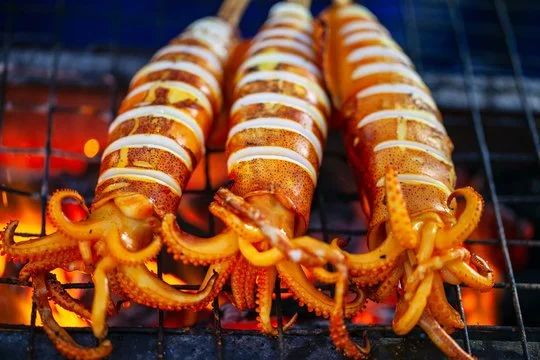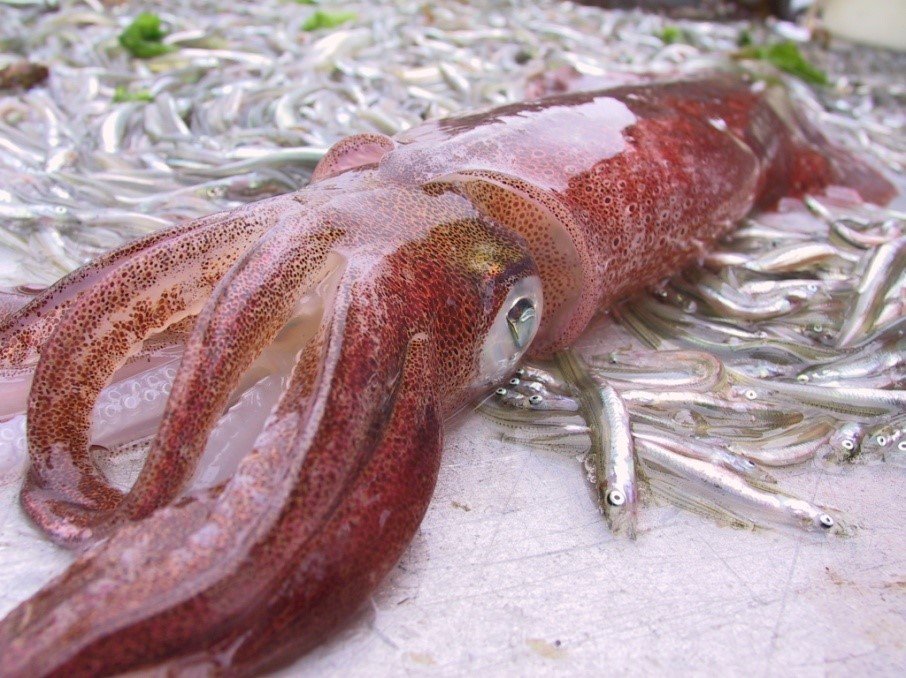shortfin squid
U.S. wild-caught shortfin squid is a smart seafood choice because it is sustainably managed and responsibly harvested under U.S. regulations.
Population
A stock assessment is done annually because the species has a lifespan of less than one year.
Fishing Rate
At recommended level.
Habitat Impacts
Fishing gears used to harvest shortfin squid have minimal impacts on habitat.
Bycatch
Regulations are in place to minimize bycatch.
Population Status
According to the latest assessment, shortfin squid is not subject to overfishing. There is currently not enough information to determine the population size, so it is unknown.
Appearance
Female shortfin squid range from 7 to 12 inches in mantle length, while males are 7 to 10.6 inches in mantle length.
They can regulate their body color, but are primarily orange-colored with a brown stripe that extends along the top side of the mantle.
Biology
Shortfin squid live for less than one year. They have a high natural mortality rate, and a long spawning season.
Females can release multiple egg masses during a single spawning season, but die after they spawn. Spawning can occur year round with seasonal peaks from October to June.
Shortfin squid have extremely variable birth, growth, and maturity rates. This makes them extremely sensitive to climate-driven changes.
They grow about one millimeter a day.
Shortfin squid are visual predators that eat crustaceans, fish, and other squid, including their own species.
They are food for many fish, including bluefin tuna, silver hake, red hake, bluefish, goosfish, fourspot flounder, Atlantic cod, sea raven, spiny dogfish, and swordfish. Seabird predators include shearwaters, gannets, and fulmars.
Shortfin squid undergo daily vertical migrations between cooler deep water and warmer surface water. They are nearest the seabed during the day, and higher in the water column during the night.
Where They Live
Shortfin squid inhabits the continental shelf and slope waters of the Northwest Atlantic Ocean, from Newfoundland to the central east coast of Florida.
In the northwest Atlantic Ocean, shortfin squid are most often caught along the continental shelf break in depths between 150 to 275 meters.
Harvest
In 2019, commercial landings of shortfin squid totaled approximately 58 million pounds, and were valued at approximately $27.3 million according to the NOAA Fisheries commercial fishing landings database. These figures may not match other agency sources of data due to confidential information.
Fisheries for shortfin squid reflect the species’ seasonal migrations.
The majority of landings come from Rhode Island and New Jersey.
Harvested for bait domestically, and exported for bait and food.
Gear types, habitat impacts, and bycatch:
The majority of shortfin squid is harvested June 1 through October 31 using small-mesh bottom trawls. The fishery is open year round, but the squid aren’t available in commercial quantities year round.
Sandy or muddy habitat, where squid are fished, is less sensitive to the impacts of trawling.
Small-mesh bottom trawls can incidentally catch marine mammals and large pelagic species, including pilot whales, common dolphin, swordfish, and a variety of sharks, ray, and tuna species. Finfish such as butterfish, hakes, longfin squid, summer flounder, herring, spiny dogfish, and Atlantic mackerel are also incidentally caught in this fishery.
Measures to prevent or minimize bycatch include:
Fishing must occur seaward of the 50-fathom depth line to reduce finfish and longfin inshore squid bycatch.
Outreach to fishermen to educate them on actions to take in the event of a marine mammal interaction.
Real-time communication to vessels regarding hotspots of marine mammal interactions.
Article source: NOAA
Photo captured by: Empire Fisheries
LONGFIN SQUID
This is the type of squid you are likely to be most familiar with eating, for example as calamari.
U.S. wild-caught longfin squid is a smart seafood choice because it is sustainably managed and responsibly harvested under U.S. regulations.
Population Status
The species has a lifespan of less than one year. According to the 2020 stock assessment, longfin squid are not overfished.
Appearance
Longfin squid have an internal shell called a “pen.”
Their fins are long, at least half the length of the mantle (large part of the squid in front of the head).
The head has large eyes that are covered by a cornea.
They are pink or orange and mottled with brown or purple.
They are likely color blind, but are able to use special pigment cells in their skin (called chromatophores) to change their color and patterns to escape predators or disguise themselves from prey.
Biology
Longfin squid grow fast, up to 1.6 feet mantle length (large part of the squid in front of the head), but usually less than 1 foot.
They have a short life span, reproducing right before they die at around six to eight months old.
Their growth and development is highly sensitive to environmental conditions. Squid hatched in the summer grow faster than those hatched in the winter.
They spawn year-round, with peak production in winter and summer. The male cements bundles of spermatophores into the mantle cavity of the female and/or deposits them in a pouch located near her mouth. The spermatophores penetrate the ova, or sperm is stored for later use.
The female lays fertilized egg capsules that contain about 150 to 200 eggs each in clusters attached to the ocean bottom, with a typical female laying a total of 3,000 to 6,000 eggs. Eggs hatch between 11 and 26 days later, depending on water temperature.
Small immature longfin squid feed on plankton, and larger squid feed on crustaceans and small fish.
They are aggressive hunters, can consume fish larger than themselves, and do eat their own species.
They are a key prey species for a variety of marine mammals, diving birds, and finfish species.
Where They Live
Longfin squid are found from Newfoundland to the Gulf of Venezuela.
In the northwest Atlantic Ocean, longfin squid are most abundant between Georges Bank and Cape Hatteras, North Carolina.
Harvest
In 2019, commercial landings totaled more than 27 million pounds, and were valued at approximately $43 million, according to the NOAA Fisheries commercial fishing landings database.
Fisheries for longfin squid reflect the species’ seasonal migrations.
The majority of landings come from Rhode Island, New York, New Jersey, and Massachusetts.
Harvested for bait since the late 1800s, longfin squid have been harvested since the mid-1960’s for their mild, sweet meat.
The majority of longfin squid is harvested year-round using small-mesh bottom trawls. There are now only a few fishermen that use pound nets and fish traps during the spring and early summer when squid migrate inshore.
Sandy or muddy habitat, where squid are fished, is less sensitive to the impacts of trawling.
Article source: NOAA
Source: https://longislandsoundstudy.net


